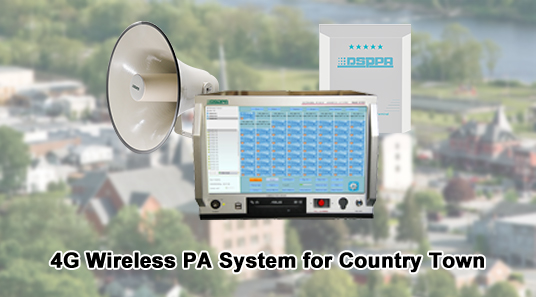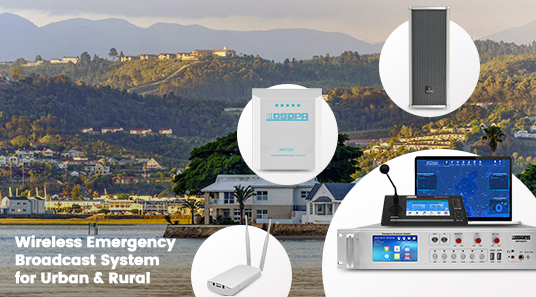
Requirement Analysis
● In practical applications, multiple systems—such as the public address system, surveillance system, LED information release system, and video intercom system—often operate independently. This results in frequent switching between platforms and the inconvenience of managing multiple login accounts and device addresses.
● In Phase I of the emergency broadcast project, third-party equipment was used. However, for Phase II, the client intends to add DSPPA devices and seeks seamless integration.
● Outdoor installation locations are widely distributed, raising the need for map-based location tracking and display.
● The client already has an existing management platform and wishes to achieve system integration.
● Some outdoor points lack both power and internet access, requiring flexible solutions that can adapt to such limitations.

Emergency Broadcast System Deployment Requirements

● The construction of emergency broadcast systems aligns with the national requirements for public emergency alert dissemination and the development of a unified emergency broadcasting network.
● Emergency broadcasting serves as a crucial channel for governments to deliver and disseminate information during public emergencies such as natural disasters, industrial accidents, public health incidents, and social security events.
● As an integral part of the public service infrastructure, emergency broadcasting also plays a key role in guiding public opinion, communicating government directives, and releasing important information during normal times.
System Overview
DSPPA Audiovisual Cloud Broadcast System

Development History

System Topology Diagram Example

System Architecture Diagram

Categorized by Application Modules

System Advantages

Application Scenarios

Product Details
Audiovisual Cloud Broadcast Management Platform

● Built on a hybrid B/S & C/S architecture with flexible deployment options
● Supports multi-user permission management and scheduled tasks
● Enables AV broadcasting, real-time TTS, live paging, visual intercom, and zone paging
● Supports real-time video monitoring, split-screen, polling, and broadcast linkage
● Displays integrated data statistics with charts and radar graphs
● Supports GIS mapping, offline maps, and satellite map display
● Enables AV interaction via WebRTC-based web and device communication
● Supports RTMP, RTSP, HTTP-FLV, and SRT AV streaming formats
● Supports effect evaluation logs and broadcast recording
● Compatible with GB28181, HTTP API, Modbus TCP, and emergency broadcast protocols
● Certified by SARFT with third-party test report (brand/model: OTWEA Model)
Integrated Touch-Based Broadcast Control Platform

● Integrated design combining platform software and server hardware
● Touchscreen-based broadcast control host with built-in multi-channel audio inputs
● Built on a hybrid B/S & C/S architecture
● Supports multi-user permission management
● Enables AV broadcasting, real-time text-to-speech, live announcements, visual intercom, and zone paging
● Supports real-time video monitoring, split-screen display, polling, and broadcast linkage
● Displays comprehensive data statistics with charts and radar graphs
● Supports GIS mapping with offline and satellite map display
● Supports low-latency multicast and customizable unicast within the LAN; lab instrument tests show end-to-end audio transmission (input → network → output) latency as low as 48ms.
● Supports evaluation log recording and broadcast audio recording
● Compatible with GB28181, HTTP API, Modbus TCP, and emergency broadcast platform protocols
IP Paging Microphone

Mobile APP

Multi-functional Integrated Host

FM Transmitter

Multi-Mode Receiver Terminal
The system offers a variety of receiving terminals to choose from, allowing flexible selection based on different environments and requirements. These terminals support outdoor installation and feature waterproof and dustproof capabilities.

Multi-Mode Receiver Column Speaker
The system supports multiple models of receiving column speakers, allowing flexible selection based on specific environmental conditions and application needs. These speakers are suitable for outdoor use, with robust waterproof and dustproof performance.

Solar Module
The solar module is designed to supply power to outdoor cloud broadcast terminals, addressing the issue of unavailable mains electricity in remote areas. It can be selected or customized based on various requirements.

Indoor Wall Mount Terminal

Indoor Network Speaker

Visual Intercom Terminal

Audiovisual Broadcast Control Terminal

Emergency Broadcast System for Zhejiang Wencheng County
Emergency Broadcasting Audio-Visual Integration Project: Covering All Towns and Villages in the County

Cloud Broadcast System for Sanya Jiyang District Phase II Dadonghai

Emergency Broadcast System for Guangdong Province
DSPPA Cloud Broadcast System Enables Seamless Cross-Regional Transmission!

Emergency Broadcast System for Shenzhen Longhua Drainage Canal

Emergency Broadcast System for the Yuanba Gas Field, Sichuan

Early Warning Broadcast System for Jinchuan Hydropower Station, Aba Prefecture, Sichuan

Intelligent Traffic Broadcast Project in Jianggao, Baiyun District, Guangzhou
● Jianggao Town is dedicated to exploring innovative approaches to traffic safety awareness. As one of the national high-tech enterprises based in Jianggao, DSPPA Group has actively responded to the initiative by supporting the development of an intelligent traffic cloud broadcast system. To date, 137 wireless broadcasting points have been installed across key intersections and road sections, laying a solid foundation for a safe and orderly traffic environment through the power of technology.

Additional Case Examples


 4G Wireless PA System for Country TownApril 30, 20201. Solution DescriptionDuring the epidemic, many county towns can not receive news on epidemic prevention and control, resulting in unpredictable consequences; th...view
4G Wireless PA System for Country TownApril 30, 20201. Solution DescriptionDuring the epidemic, many county towns can not receive news on epidemic prevention and control, resulting in unpredictable consequences; th...view 4G Wireless Emergency Broadcast SystemSeptember 23, 2021The emergency broadcast system is an important part of the construction of the public service system of radio, film and television, and plays an important role in public opinion guidance, government order transmission, information release and emergency broadcast.view
4G Wireless Emergency Broadcast SystemSeptember 23, 2021The emergency broadcast system is an important part of the construction of the public service system of radio, film and television, and plays an important role in public opinion guidance, government order transmission, information release and emergency broadcast.view